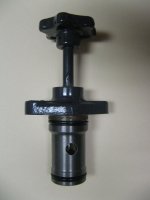Looking way back in a couple of threads about this, someone (maybe Harvest Moon?) tried swapping the lowering speed valve, but without much change.
From what I can see, the lowering speed valve is a check valve of sorts. It's spring loaded to allow full flow into the lift cylinder regardless of the valve setting, but fluid must bleed past it without lifting the poppet valve on the return path, thus controlling the lower rate.
I think this is part of the problem, or maybe part of the solution.
The position feedback system on the L series provides what I call "active position control" so the 3 PH will stay in the same position regardless of cylinder leakdown as long as the hydraulic pump is running. In other words, if the 3 PH starts to lower, the feedback linkage opens the supply valve and brings it back to the original position without any input from the operator.
If, and this is the key question, the flow into the lift cylinder is not damped properly and acts like an on-off switch, the lift will be jerky. Is it possible that is what's causing the problem??
I can't think of what else would make it jumpy other than that. To illustrate, if you have 2000 lbs of lifting force being applied suddenly to the lift arms, they will jump upwards. If you have 2000 lbs of implement on the lift arms and the lowering valve is fully open, it's tough to lower that smoothly also.
So, to get to the point, what would happen if we were to eliminate the check valve effect of the lowering valve?? There is only one path for fluid to get into and out of the lift cylinder, it's a single acting cylinder, remember.
If the spring arrangement on the lowering valve was eliminated, so that it restricted flow in both directions instead of only one, is there any negative effect to that? The only one I can see is that the relief valve on the 3 point system will bypass any excess flow back to the sump when you move the lever to the raise position. To illustrate, the L3400 hydraulic pump generates rough 9 GPM at 2300 psi at rated engine speed. When you move the position control lever, all 9 GPM is going to the lift cylinder unless the relief valve opens.
There's no flow divider or "splitter" in the system as far as I know. If you restrict the supply route to the cylinder via the lowering valve restricting flow in both directions instead of only one, you can reduce the flow rate into the cylinder as much as you want to, any excess will go through the relief valve and to sump once you reach the relief valve setting at 2300 psi. I can't see much harm in that as long as you don't do it continuously for an extended period, which could overheat the oil.
It's the same as trying to lift too much weight with the loader, it simply buzzes the excess flow through the relief valve as long as you hold the valve depressed. In fact, there would be less fluid going over the relief valve since there is some going into the lift cylinder at the same time, unless you have the valve totally closed.
This is all based on the belief that the lowering valve is installed between the position control valve and the cylinder itself, I can't imagine it being anywhere else in the circuit.
I thought of this because the lift action is noticeably smoother if there's another load applied to the hydraulic system at the same time, e.g. raising the loader. That's not practical in everyday use, obviously.
Looking for your thoughts on this, what am I missing in the equation??
Sean
